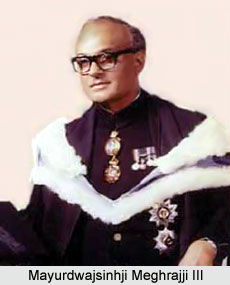 Mayurdwajsinhji Meghrajji III was the last ruling Indian Prince or Maharaja of the princely state of Dhrangadhra Halvad. Meghrajji was also a renowned politician, academic and member of numerous eminent academic organisations. He was amongst the final surviving native rulers of the erstwhile princely states of the British Empire in India. Maharaja Mayurdwajsinhji Meghrajji III of Dhrangadhra was also the last surviving knight of the Order of the Indian Empire and the final surviving member of either of the chivalric orders of British Indian Empire.
Mayurdwajsinhji Meghrajji III was the last ruling Indian Prince or Maharaja of the princely state of Dhrangadhra Halvad. Meghrajji was also a renowned politician, academic and member of numerous eminent academic organisations. He was amongst the final surviving native rulers of the erstwhile princely states of the British Empire in India. Maharaja Mayurdwajsinhji Meghrajji III of Dhrangadhra was also the last surviving knight of the Order of the Indian Empire and the final surviving member of either of the chivalric orders of British Indian Empire.
Early Life of Mayurdwajsinhji Meghrajji III
Mayurdwajsinhji Meghrajji III was born at Sundar Villas, Dhrangadhra on 3 March 1923 as the 2nd son of Maharaja Sir Ghanshyamsinjhi Ajitsinhji Sahib Bahadur, the native ruler of the of the 13 gun salute state of Dhrangadhra Halvad, and Maharani Anand Kunverba Sahiba, his third wife. Mayurdwajsinhji was the eldest surviving son of Ghanshyamsinjhi Ajitsinhji Sahib Bahadur. Initially he was educated at a local school and later went to England where he first attended Millfield School in Somerset and then the Heath Mount School in Hertfordshire. Meghrajji III later received education from Haileybury College in Hertfordshire, after which he returned to India and succeeded his father as the new Maharaja of Dhrangadhra Halvad state. He later studied at St. Joseph`s Academy in Dehradun and at the Shivaji Military School in Pune.
Rule of Mayurdwajsinhji Meghrajji III
After the death of his father Maharaja Sir Ghanshyamsinjhi Ajitsinhji Sahib Bahadur in the year 1942, Mayurdwajsinhji Meghrajji III succeeded him and ascended the throne of the princely state as the Maharaja. He served as the Patron of Talukdari Girassia College and of the Bhandarkar oriental Research Institute during his reign as the native ruler. From the year 1945 to 1947, Meghrajji III was appointed as a member of the Standing Committee of the Chamber of Princes. He ruled over the territory for a brief period as after the independence of India in the year 1947, he signed an Instrument of Accession to India. Maharaja Mayurdwajsinhji Meghrajji III of Dhrangadhra was knighted by being appointed a member of the Order of the Indian Empire in 1947.
Meghrajji III supported the cause of national independence and served as a member of the Constituent Assembly of India from the year 1947 to 1948. On 15th February 1948, the native ruler merged his state Dhrangadhra Halvad with the United State of Kathiawad. The territory was later incorporated as a part of the Union of Saurashtra.
Personal Life of Mayurdwajsinhji Meghrajji III
Maharaja Mayurdwajsinhji Meghrajji III of Dhrangadhra Halvad was married to Maharani Shrimati Sri Rajni Brijraj Kunverba Sahiba of Jodhpur in the year 1943. The royal couple had 3 sons, namely Patvi Namdar Jhalavrit Maharajkumar Shri Sodhsalji Shatrujitdev Sahib, Yuvaraja of Dhrangadhra Halvad; Maharajkumar Shri Dr. Jayasinhji Jawahirdev Sahib, PhD, MSc; and Maharajkumar Shri Siddhrajsinhji Gautama Deo Sahib.
Since the year 1966, Meghrajji III served as the President of Rajkumar College and the Sri Rajaram Educational Foundation. He was also a member of the Indian Council of World Affairs, the Millfield Society, the Commonwealth Parliamentary Association, the Indian Parliamentary Group, the Numismatic Society of India, the Numismatic Society of India, the World Wildlife Fund and the Heraldry Society of India. The former ruler was a Fellow of the Royal Anthropological Institute of Great Britain and Ireland and the Royal Asiatic Society. He was a Fellow of the Royal Historical Society and a member of the Cricket Club of India.
The Maharaja of Dhrangadhra Halvad died at the age of 87 on 1 August 2010, due to old age. His eldest son succeeded him as the Maharaja of Dhrangadhra Halvad.
Titles of Mayurdwajsinhji Meghrajji III
The name and title of Mayurdwajsinhji Meghrajji III was His Highness Shri Shaktimant Jhaladipati Mahamandleshwar Maharana Sriraj Maharaja Sir Mayurdwajsinhji Meghrajji III Ghanshyamsinjhi Sahib Bahadur, Maharaja Raj Sahib of Dhrangadhra Halvad, KCIE, FRAS, FRAI, FRHistS. He also held several titles through out his reign, which are discussed as follows-
* Patvi Namdar Jhalavrit Maharajkumar Shri Meghrajji Ghanshyamsinjhi Sahib, Yuvraj of Dhrangadhra Halvad (1923- 1942)
* His Highness Shri Shaktimant Jhaladipati Mahamandleshwar Maharana Sriraj Maharaja Mayurdwajsinhji Meghrajji III Ghanshyamsinjhi Sahib Bahadur, Maharaja Raj Sahib of Dhrangadhra Halvad (1942- 1947)
* His Highness Shri Shaktimant Jhaladipati Mahamandleshwar Maharana Sriraj Maharaja Sir Mayurdwajsinhji Meghrajji III Ghanshyamsinjhi Sahib Bahadur, Maharaja Raj Sahib of Dhrangadhra Halvad, KCIE (1947- 2010)
Honours of Mayurdwajsinhji Meghrajji III
Mayurdwajsinhji Meghrajji III was honoured several times through his rule over the state. These are mentioned below-
* King George VI Coronation Medal (1937)
* Knight Commander of the Order of the Indian Empire- KCIE (1947)
* Indian Independence Medal (1947)
* Queen Elizabeth II Coronation Medal (1953)



















